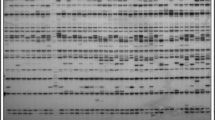Abstract
The diversity of 27 superior tea (Camellia sinensis var. sinensis) accessions from Korea, Japan and Taiwan was examined with RAPD-PCR (Random Amplified Polymorphic DNA Polymerase Chain Reaction) markers. Out of the 50 primers screened, 17 primers generated 58 polymorphic and reproducible bands. A minimum of 3 primers was sufficient to distinguish all the 27 accessions studied. The Shannon's index used to partition diversity into inter- and intra-group, revealed that 71 percent of variability resided within groups and 29 percent between groups. Diversity was greatest within the Korean group followed by Taiwan and Japan. The relatively high diversity observed in Korea might reflect the larger genetic base of its plantations while the low diversity in Japan could be explained by the long and intensive tea selection programme in this country. A dendrogram based on the UPGMA-link method using Jaccard's distances and multivariate Factorial correspondence analysis clustered the tea accessions into two main groups, regrouping the Taiwan cultivars on the one side and the Korean and Japanese accessions on the other side. This suggests that the Taiwan tea studied here may have a different origin from that of Korea and Japan.
Similar content being viewed by others
References
Ashburner, G.R., W.K. Thomson & G.M. Halloran, 1997. RAPD analysis of South Pacific Coconut palm populations. Crop Sci 37: 992-997.
Banergee, B., 1992a. Botanical classification of tea. In: K.C.Wilson & M.N. Clifford (Eds.), Tea: cultivation to consumption, pp. 25-51. Chapman and Hall, London.
Banergee, B., 1992b. Selection and breeding of tea. In: K.C.Wilson & M.N. Clifford (Eds.), Tea: cultivation to consumption, pp. 53-85. Chapman and Hall, London.
Chakraborty, R. & C.R. Rao, 1991. Measurements of genetic variation for evolutionary studies. Handbook of Statistics. Elsevier, Amsterdam.
Beckmann, J.S. & M. Soller, 1983. Restriction fragment length polymorphisms in genetic improvement: methodologies, mapping and cost. Theor Appl Genet 67: 35-43.
Chengyin, L., L.Weihua & L. Mingjun, 1992. Relationship between the evolutionary relatives and the variation of esterase isozymes in tea plant. Journal of tea science 12: 15-20.
Choi, S., 1991. Studies of the aroma of Korean green tea. In: ISTS (Eds.), Proceedings of the International Symposium of Tea Science, pp. 130-134. ISTS, Japan.
Green, M.J., 1971. An evaluation of some criteria used in selecting large yielding tea clones. J Agric Sci 76: 43-156.
Hamrick, J.L., 1990. Isozymes and the analysis of genetic structure in plant populations. In: E.D. Soltis & P.S. Soltis (Eds.), Isozymes in plant biology, pp. 87-90. Chapman and Hall, London.
Howell, E.C., H.J. Newbury, R.L. Swennen, L.A. Withers & B.V. Ford-Lloyd, 1994. The use of RAPD for identifying and classifying Musa germplasm. Genome 37: 328-332.
Ikeda, N., M. Kawada & Y. Takeda, 1991. Isozyme analysis of Camellia sinensis and its interspecific hybrids. In: ISTS (Eds.), Proceedings of the International Symposium of Tea Science, pp. 451-455. ISTS, Japan.
Jaccard, P., 1908. Nouvelles recherches sur la distribution florale. Bulletin Societe Vaudoise des Sciences Naturelles 44: 223-270.
Matsumoto, S., A. Takeuchi, M. Hayatsu & S. Kondo, 1994. Molecular cloning of phenylalanine ammonia-lyase cDNA and classification of varieties of tea plants (Camellia sinensis) using tea Pal cDNA probe. Theor Appl Genet 89: 671-675.
Orozco-Castillo, C., K.J. Chalmers, R. Waugh & W. Powell, 1994. Detection of genetic diversity and selective gene introgression in coffee using RAPD markers. Theor Appl Genet 87: 934-940.
Owuor, P.O., T. Takeo, H. Horita, T. Tojiro & T. Murai, 1987. Differentiation of clonal teas by terpene index. J Sci Food Agric 40: 341-345.
Prenner, G.A., A. Bush, R. Wise, W. Kim, L. Dommier, K. Kasha, A. Laroche, G. Scoles, S.J. Molnar & G. Fedak, 1993. Reproducibility of Random amplified polymorphic DNA (RAPD) analysis among laboratories. PCR methods Applic 2: 341-345.
Sealy, J., 1958. A revision of the genus Camellia. Royal Horticultural Society (Ed.), London.
Skroch, P.W. & J. Nienhuis, 1995. Qualitative and quantitative characterization of RAPD variation among snap bean (Phaseolus vulgaris) genotypes. Theor Appl Genet 91: 1078-1085.
Sul, I.W. & S.S. Korban, 1996. A highly efficient method for isolating genomic DNA from plant tissues. Plant Tissue Culture and Biotechnology 2: 113-116.
Tanksley, S.D., N.D. Young, A.H. Paterson & M.W. Bonirbale, 1989. RFLP mapping in plant breeding: new tools for an old science. BioTechnology 7: 257-264.
Wachira, F.N., W. Powell & R. Waugh, 1997. An assessment of genetic diversity among Camellia sinensis L. (cultivated tea) and its wild relatives based on randomly amplified polymorphic DNA and organelle-specific STS. Heredity 78: 603-611.
Wachira, F.N., R. Waugh, C.A. Hackett & W. Powell, 1995. Detection of genetic diversity in tea (Camellia sinensis) using RAPD markers. Genome 38: 201-210.
Wight, W., 1962. Tea classification revised. Curr Sci 31: 298-299.
Willams, J.G.K., A.R. Kubelik, K.J. Livak, J.A. Rafalsky & S.V. Tingey, 1990. DNA polymorphisms amplified by arbitrary primers are useful as genetic markers. Nucleic Acids Res 18: 6531-6535.
Wilde, J., R. Waugh & W. Powel, 1992. Genetic fingerprinting of Theobroma clones using randomly amplified polymorphic DNA markers. Theor Appl Genet 83: 871-877.
Wikramaratne, M.R. 1981. Variation in some leaf characteristics in tea (Camellia sinensis L.) and their use in the identification of clones. Tea Q 50: 183-189.
Yang, X. & C. Quiros, 1993. Identification and classification of celery cultivars with RAPD markers. Theor Appl Genet 86: 205-212.
Author information
Authors and Affiliations
Rights and permissions
About this article
Cite this article
Kaundun, S.S., Zhyvoloup, A. & Park, YG. Evaluation of the genetic diversity among elite tea (Camellia sinensis var. sinensis) accessions using RAPD markers. Euphytica 115, 7–16 (2000). https://doi.org/10.1023/A:1003939120048
Issue Date:
DOI: https://doi.org/10.1023/A:1003939120048




